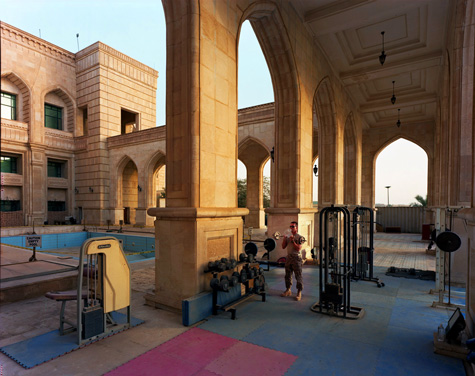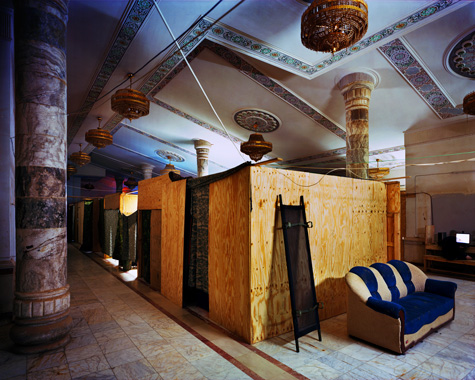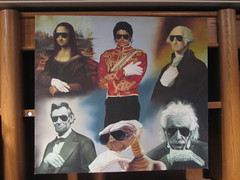I can't get this painting out of my head. It is saying something
important. I mean it. Go to the Flickr page and look at it for as long as you can.Many of the contents of Neverland Ranch were put
up for auction in February, then
returned to Michael. (The photo is from Paul Scheer's great
photoset of the auction, via
Boing Boing.) It seems clear, though, that Michael won't return to his ranch. As my friend
Sean observed, Neverland should have been preserved like Graceland, a shrine to a great American and his legend. It's a tragedy for all of us that it's being disassembled and sold off, whether by Michael or someone else.
Rob Walker
reflects on the painting:
It is, really, some kind of achievement. It is the bad painting to end all bad paintings — and I want it. Thus it is one of the most American things I have ever seen. It is beyond description. It should be turned into a poster and given for free to every household. It speaks for itself.
He's right. This painting contains important lessons about the meaning of fame, the uses of history, and the way we can only read the past through the lens of the present. It is the most totally honest work of art I've seen in a long time.
The shades and the gloves: Mona, George, Albert, Abe and E.T. all pay homage to the man that has eclipsed them. They look GOOD in the gloves and shades, too. You can see it as a conceit, but honestly? Michael Jackson has affected more lives than any of them did. Billions of people know his music. He lives inside my mind, and your mind, and everyone's mind, and has made us
feel it and shake it and beat it. At his white-glove peak, he was more important than the other five put together. He may still be.
The painting states something obvious and true: that Michael has entered history, and colored all of American culture with his music. The mind that takes in the Mona Lisa is also a mind that is hardwired with the bassline of 'Smooth Criminal'. We can never again understand them separately.
This is not simply because Michael Jackson is great (he is), but because as time passes, it changes how we are able to perceive it. Each historical moment has its mix of ideas, sounds, colors, concepts, and feelings through which we see the past. The past doesn't exist outside of the lens we see it through. Michael came crashing like a tsunami into popular culture and changed the shape of the lens. He
bends light.
Michael understands that he is a transcendant figure. He doesn't do humble. He knows he has mythical powers and historical importance, and lives accordingly. He transformed himself into a white man. In Neverland, he created his own realm where he was benevolent king. He wants to be remembered for his mythical essence: a kindly god of music, a Dionysus stripped of his wildness, a patron saint of children. Michael tried to
literally live inside
this myth of himself. This painting, and all the other weird stuff in Neverland, are reflections of fact. Michael has tried to live as an historical figure, as a mythical man,
while he was still alive.
People treat this as comedy, but it is his tragic flaw. If Michael was dead, we could write his hagiography, and translate the inconvenient truths of his mortal life into the safety of myth. He could be what he is - larger than life, a musical genius, a towering figure of American culture - without his human struggles getting in the way.
Michael sees himself very clearly. But sometimes self-knowledge is a route to destruction. For some reason he reminds me of Aeschylus' Cassandra: she has the gift of prophecy, and uses it to warn those around her of what is to come. But it doesn't change anything. For being true to herself and her supernatural gifts, she is rewarded with mockery, suffering, and death. Like Cassandra, Michael understands the transcendent parts of himself, and has tried to live them out, only to be met with hatred, mockery, and disgust.
What Aeschylus shows us - and what Michael doesn't understand - is that having the gods among us only makes life worse for the living. When the supernatural takes mortal form we instinctively see it as something destructive. This is why we demand celebrity gossip: we need to know that the people who control our psyches are even worse fuckups than we are. In other words, they have to remain human and fallible and fragile. If they refuse, they have to be destroyed.
The painting remains great. While Michael is alive, it will be seen as a work of high camp, outrageous hubris, amazing comedy. When he dies, and takes his place with Elvis in the pantheon of departed heroes, the reception of this painting will change. It will be seen for what it is: an honest and prescient assessment of his influence on American life.









